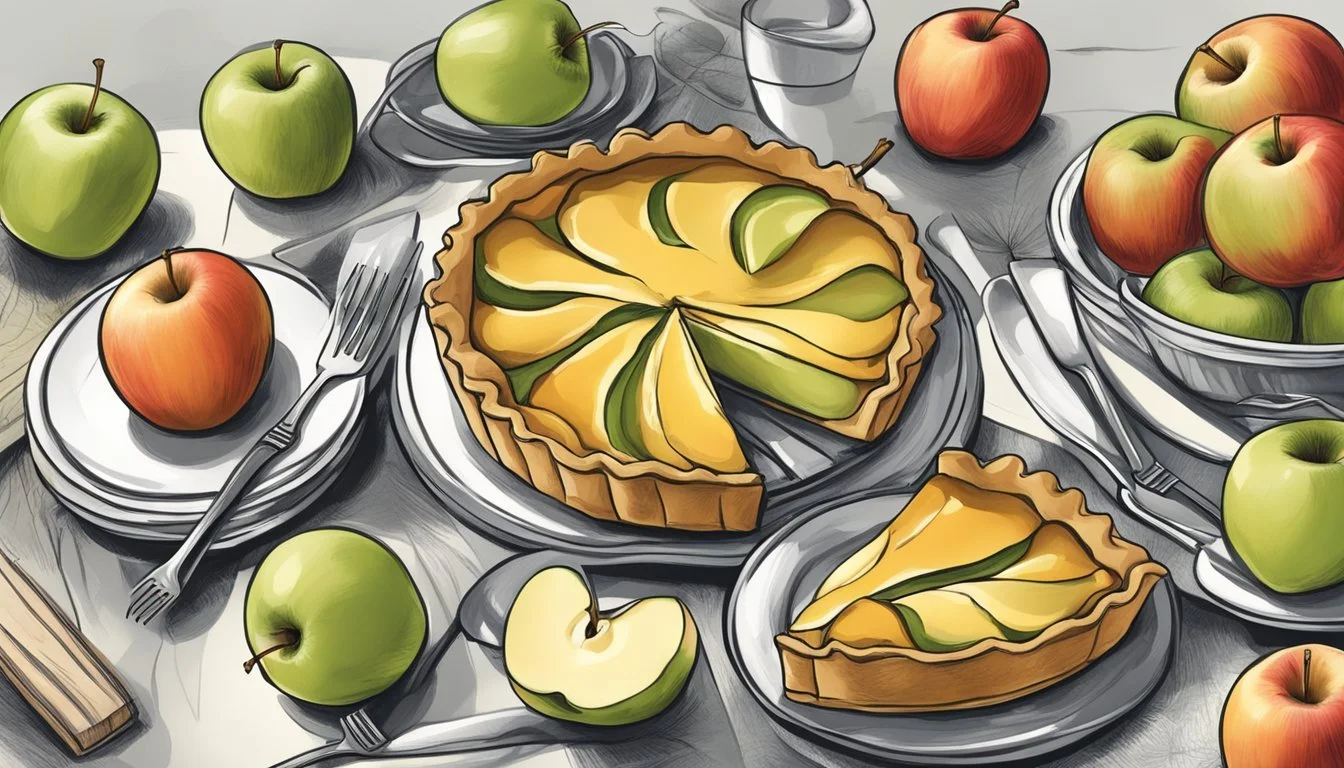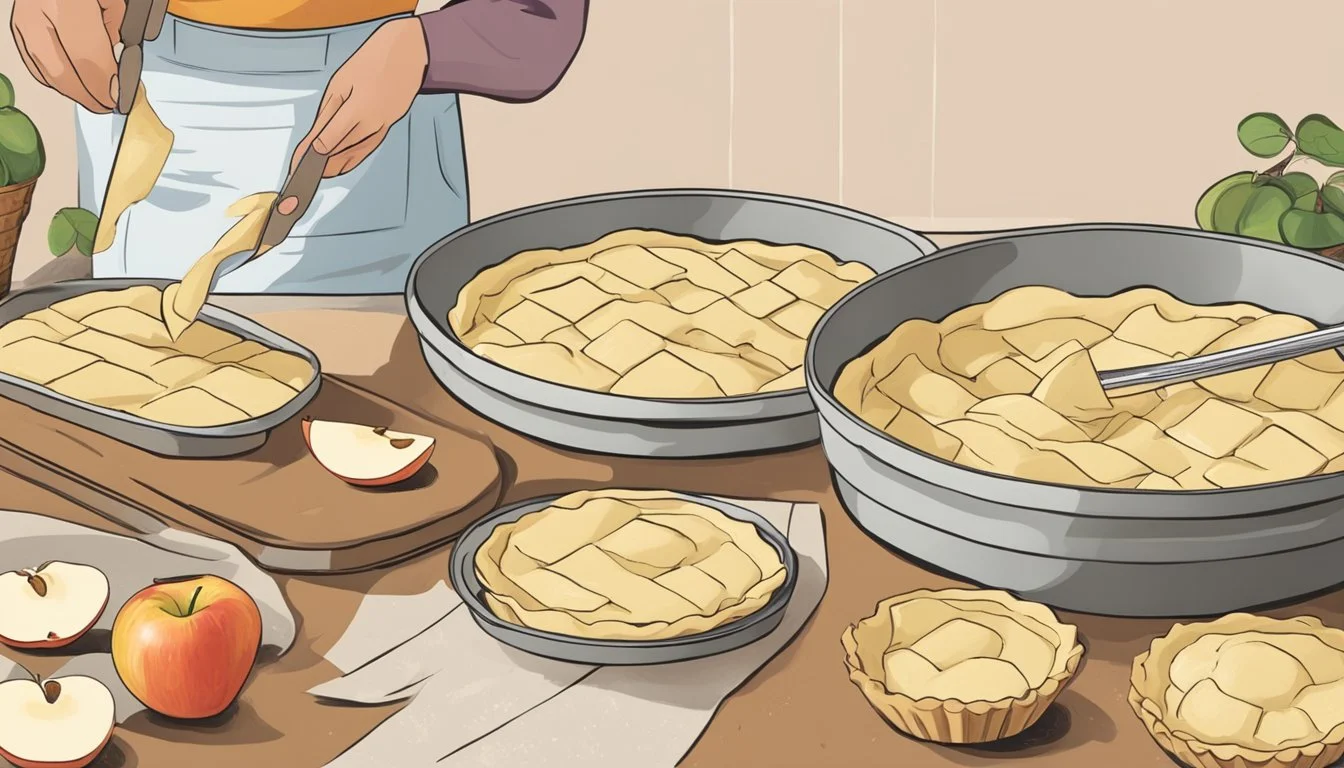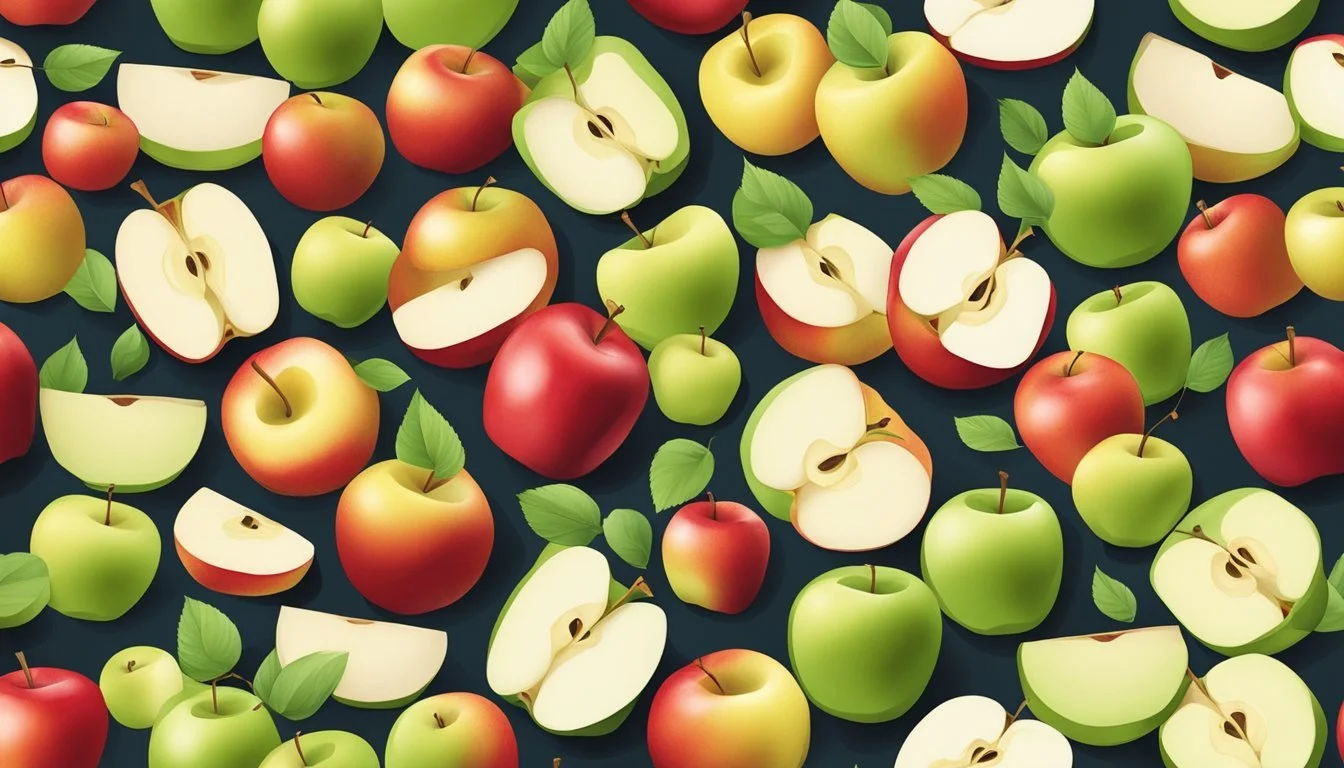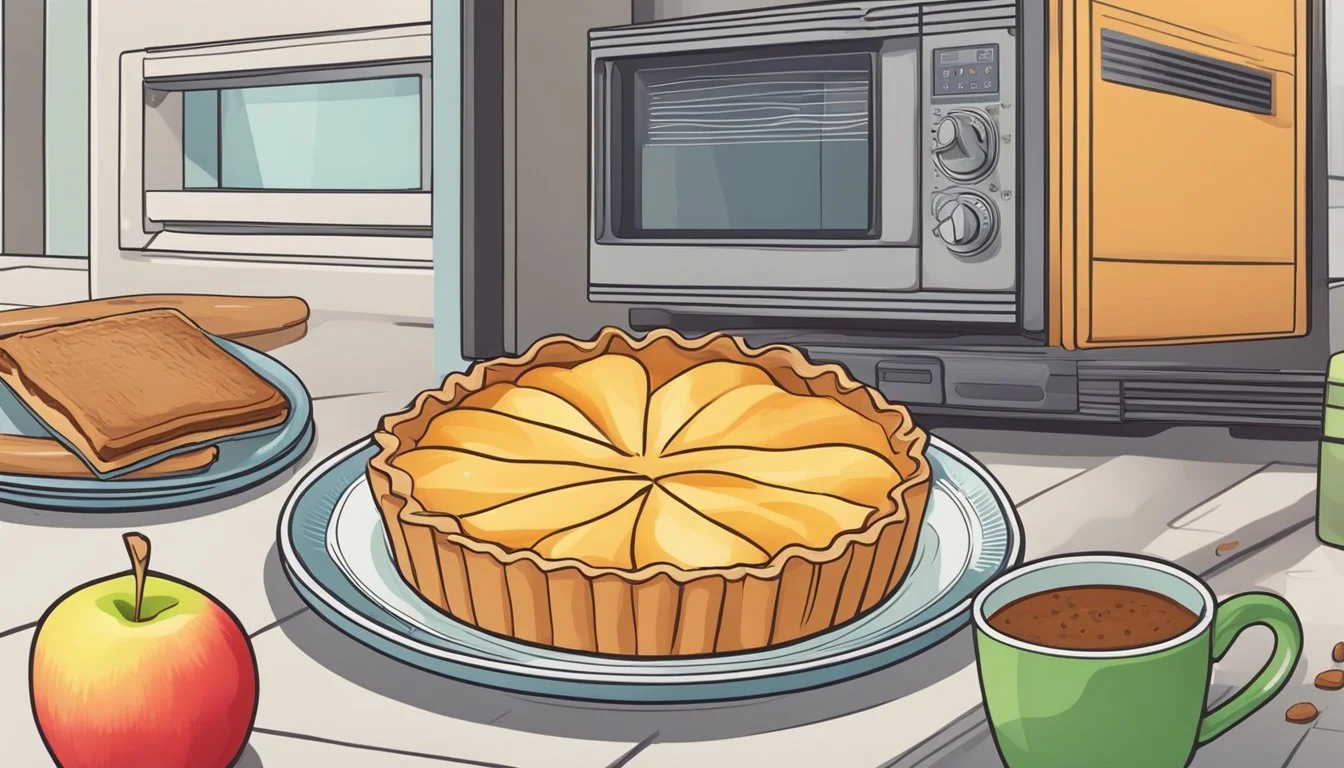How to Eat an Apple Tart:
Enjoying Your Dessert the Right Way
Eating an apple tart is a delightful experience that encapsulates the essence of dessert enjoyment. This classic dessert, with its buttery crust and sweetly spiced apple filling, has graced tables for generations. When indulging in an apple tart, there are several approaches to maximize pleasure and highlight the pastry's textures and flavors.
Temperature plays a significant role in the overall experience. Served warm, the apple tart exudes inviting aromas of cinnamon and caramelized fruit that can elevate the tasting experience. On the other hand, allowing the tart to cool to room temperature may concentrate the flavors and provide a firmer texture. Whether one prefers their dessert à la mode with a scoop of vanilla ice cream or savors the tart as a standalone treat, the apple tart offers versatility to suit any palate.
Beyond temperature, the method of consumption may vary from using utensils for a more elegant experience to enjoying slices by hand for a casual approach. The apple tart's structure, ideally with a flaky crust and tender filling, should withstand cutting yet yield easily to the fork. Each mouthful combines the crispness of the pastry with the soft, seasoned apples, creating a harmonious blend of flavors typical of a well-executed apple tart.
Choosing the Right Apples
Selecting the ideal apples for an apple tart is crucial because they influence both the flavor and texture of the dish. The variety of apple one opts for should complement the tart's sweet or tangy profile and possess the right consistency to endure baking without becoming too mushy.
Sweet vs. Tart Apples
When baking an apple tart, the choice between sweet and tart apples largely depends on personal preference.
Sweet Apples: Varieties such as Gala, Golden Delicious, and Honeycrisp offer a naturally sweet flavor, reducing the need for added sugar.
Tart Apples: For those who prefer a sharper tartness to balance the sweetness, Granny Smith and Pink Lady apples are excellent choices.
Both sweet and tart apples can be used alone or combined to create a more complex flavor profile in the tart.
Textural Considerations
The texture of the apple after baking is as important as the flavor profile.
Firm Apples: Varieties like Granny Smith, Honeycrisp, and Pink Lady maintain their structure well during baking, which is desirable for a tart's appearance and mouthfeel.
Soft Apples: Apples such as McIntosh or Rome may become too soft when baked and could be better suited for applesauce or fillings where a smoother texture is preferred.
To ensure even baking and consistency in texture, apples should be evenly sliced and arranged neatly within the tart.
Preparing the Tart Crust
Creating a tart crust is an essential foundation for a delicious apple tart. The process involves making a flaky pastry dough, shaping it to fit the tart pan, and then blind baking it to ensure a crispy base for the filling.
Making the Dough
One begins by measuring 1½ cups of all-purpose flour into a food processor, adding ¼ cup of granulated sugar and ½ teaspoon of kosher salt for flavor enhancement. Chilled, unsalted butter is then cut into cubes and added to the mixture. It's imperative to use cold butter to achieve the desired flakiness in the homemade crust. The food processor combines these ingredients until they resemble coarse crumbs, a texture that's fundamental for a tender pastry crust.
Shaping the Crust
Once the dough retains a crumbly texture, it is transferred onto a clean surface. The dough should be pressed together, forming a disc, and then rolled out to fit the size of the desired tart pan. Careful handling is key to ensuring the integrity of the pastry crust. Gently press the dough into the pan, molding it against the sides and bottom, trimming any excess dough from the edges to achieve a neat appearance.
Blind Baking Essentials
Prior to filling, the dough in the tart pan has to be 'blind baked'. One can line the crust with parchment paper and fill it with baking weights, such as dried beans or rice. This procedure prevents the crust from puffing up or shrinking. The crust should be baked in a preheated oven, generally at 375°F, until it starts to turn golden – this signifies the crust is partially cooked. After removing the weights and parchment paper, the crust is often returned to the oven for a few more minutes to crisp up the bottom, creating the ideal base for an apple tart.
Crafting the Perfect Filling
The success of an apple tart largely depends on its filling, which combines the sweetness of apples with complementary flavors and textures. Mastery in preparing the apples, enhancing the flavors, and assembling the filling is key to a memorable dessert.
Preparing the Apples
The foundation of any apple tart filling is, naturally, the apple slices. One should select firm, fresh apples—often of a tart variety like Granny Smiths for balance—and peel, core, and thinly slice them. These sliced apples are then typically tossed with lemon juice, which serves not only to add a subtle zesty flavor but also prevents the apple slices from browning during preparation.
Ingredients:
Fresh apples
Lemon juice
Instructions:
Peel the apples.
Remove the cores.
Cut into thin slices.
Toss with lemon juice immediately.
Flavor Enhancements
Adding a sprinkle of granulated sugar to the apples helps to macerate them, drawing out their natural juices. To build a complex flavor profile, brown sugar can be used alongside white sugar for its molasses-like undertones. Cinnamon often pairs with sugar for that classic apple tart spice. Each ingredient should be measured and mixed with the apple slices, ensuring each slice is coated for an even flavor throughout the tart.
Enhancements:
Granulated sugar
Brown sugar
Cinnamon-sugar
Assembling the Filling
The final step involves assembling the apple filling in the tart shell. The flavored apple slices are layered neatly, often in a pattern that spirals from the edge to the center, allowing for even cooking and a picturesque result. Some recipes may call for the creation of an apple compote, which involves cooking down some of the apples into a thick and rich mixture before adding the fresh apple slices on top.
Processing:
Layer the sugared and spiced apple slices in the tart shell.
If using, spread apple compote on the base of the shell before layering.
Arrange neatly for even baking and presentation.
Baking the Apple Tart
When preparing an apple tart, one must pay careful attention to oven temperature and baking time to achieve the perfect balance of flaky crust and tender apple filling.
Oven Temperature and Timing
The oven temperature for baking an apple tart is typically set at 375°F (190°C). Most apple tart recipes require the tart to bake for around 45 to 60 minutes, depending on the specific recipe and oven characteristics. For instance, a rustic apple tart may need a longer baking time compared to a simple easy apple tart recipe due to its potentially thicker crust or larger size.
Preheat the oven to 375°F (190°C).
Bake the tart for 45 to 60 minutes.
Testing for Doneness
To determine if the apple tart is done, they should look for golden-brown coloration of the crust and make sure the apples are tender. A toothpick or a sharp knife can be inserted into the apple filling; it should go through the apples with minimal resistance. If there's a glaze, one might apply it during the final few minutes of baking or after removing the tart from the oven.
Visual cues: Golden-brown crust and tender apples.
Touch test: Apples should feel soft when poked.
Tool test: A toothpick or knife should slide through easily.
The baker might choose to reheat the tart before serving to enjoy it warm. This is typically done in an oven at a low temperature, such as 350°F, for about 10 to 15 minutes to prevent the tart from drying out. If the tart contains a large egg in the recipe, it has added richness and structure, hence reheating should be done cautiously to avoid overcooking.
Garnishing and Serving
When an apple tart comes out of the oven, garnishing and serving are crucial steps to elevate the dessert's appeal and taste. The right garnishes not only add visual interest but can also enhance the flavors of the tart.
Adding the Final Touches
A glaze made from apricot jam, gently heated and then brushed over the warm tart, can add a lustrous sheen and a hint of sweetness. Dietary considerations often involve the nutrition information, and as such, a light apricot glaze contributes minimal additional calories while offering richness to the palate.
For those preferring a creamy contrast, a dollop of whipped cream atop each slice serves as a cloud-like complement to the spiced apple filling. An option for added indulgence is a drizzle of caramel sauce, which brings a buttery, toffee-like flavor to each mouthful.
Presentation Ideas
Apple rose tart: To create a rose-like design on an apple tart, thin apple slices can be rolled and arranged into a floral pattern prior to baking. This method can be time-consuming but results in an impressive display suitable for special occasions.
Serving a slice of apple tart with a side of whipped cream flavored with pure vanilla extract brings a subtle, fragrant depth to the dessert. It's important to opt for pure vanilla extract over imitation varieties to ensure the quality of the flavor notes.
A proper presentation is enhanced by thoughtfully plating the dessert. For instance, a caramel drizzle on the plate before placing the tart slice creates an elegant look and an additional layer of flavor waiting to be discovered upon the first bite.
Variations of Apple Tart
Apple tarts can range from the classic French recipes to creative modern renditions, each with its own distinct flavors and textures. Traditional methods often employ time-tested techniques, while contemporary twists include novel ingredients or presentation styles.
French Classics
Tarte Tatin: This is an upside-down pastry, where the apples are caramelized in butter and sugar before the tart is baked. It originates from France and is known for its richly caramelized flavor. French Apple Tart (Tarte Normande): A traditional French dessert that features a buttery pastry crust, often made with Pâté Brisée, filled with sliced apples and custard. It may also be enhanced with Calvados, an apple brandy from the Normandy region.
Modern Twists
Contemporary versions of the apple tart may introduce puff pastry for a lighter, flakier crust. They may also incorporate additional elements such as apricot preserves for glazing or integrate apple with other fruits for a unique flavor profile. Some bakers transform the classic into an apple pie-inspired tart or infuse concepts from apple cake and apple crisp, demonstrating the versatile nature of the apple as a key ingredient in desserts (What wine goes well with desserts?). Modern interpretations also often favor deconstructed or reconstructed presentations, playing with the form and structure of the traditional tart.
Storing and Reheating Tips
When preserving the freshness of an apple tart, it is critical to allow it to cool completely after baking. Storing the tart while it is still warm can introduce unwanted moisture that may result in a soggy crust. Once cooled, the tart should be wrapped tightly in plastic wrap or aluminum foil to protect it from absorbing other flavors and odors from the refrigerator. If the apple tart is to be eaten within a couple of days, refrigeration is sufficient.
For longer storage:
The tart can be frozen to extend its shelf life.
It should be wrapped securely to prevent freezer burn.
Thawed in the refrigerator before reheating.
Reheating the tart: To ensure an apple tart retains its texture and flavor during reheating, the oven is the preferred method.
Preheat the oven to 350 degrees Fahrenheit.
Remove any wrapping and place the tart on a baking sheet.
Heat for 10-15 minutes or until it is warmed through.
For those who are short on time, a microwave may be used with caution to avoid uneven heating.
Heat the tart in short intervals, checking frequently to prevent it from becoming too dry.
By adhering to these storage and reheating tips, one can enjoy their apple tart with the best preservation of its intended taste and texture.
Health Considerations
When consuming an apple tart, individuals should be mindful of the nutrition information. A typical slice of apple tart can contain varying amounts of carbohydrates, fats, and proteins. The sugar content, pivotal in both the filling and crust, may impact blood sugar levels and should be consumed in moderation, especially for those monitoring their sugar intake.
Using unsalted butter in the apple tart's crust can be a healthier option compared to its salted counterpart. Unsalted butter allows for the control over the amount of sodium in the tart, which is beneficial for those managing their salt consumption for heart health.
Ingredients to consider for a healthier apple tart:
Apples: A source of dietary fiber and vitamin C.
Sweeteners: Opt for natural sugars or sugar alternatives.
Butter: Use unsalted butter to manage sodium content.
Crust: Whole grain or almond flour can add nutritional value.
Nutritional Breakdown Example (Per Slice):
Calories: Approximately 300-400 kcal
Carbohydrates: 45-60 g
Fats: 10-20 g
Sugars: 20-30 g
Proteins: 2-4 g
Those with dietary restrictions or specific health goals should look for recipes that offer substitutions such as sugar-free alternatives, whole grain flours for fiber, or plant-based butters to reduce saturated fat content. It’s essential for consumers to consider these factors for a balanced approach to enjoying this dessert.
Pairing with Beverages
The experience of enjoying an apple tart can be greatly enhanced by the careful selection of a complementary beverage. This section explores curated wine pairings and non-alcoholic options designed to accentuate the flavors of this dessert, focusing particularly on the notes of cinnamon and vanilla often found in apple tarts.
Wine Pairings
For those who appreciate the harmony of food and wine, several pairings are standout choices for an apple tart. A key factor to consider is the balance between the tart's sweetness and the wine's profile.
Dessert Wines: Sweet dessert wines such as Sauternes or late-harvest Sauvignon Blanc highlight vanilla notes and offer a contrast to cinnamon’s warmth.
Oaked Chardonnay: The buttery flavors of an oaked Chardonnay complement the rich crust and apple filling, marrying well with the cinnamon's spicy touch.
Calvados: Although not a wine, this apple brandy from Normandy can serve as a potent pairing, amplifying the apple flavor present in the tart.
Non-Alcoholic Options
For those who prefer non-alcoholic beverages, there are various enjoyable options that can pair well with the flavors of an apple tart.
Sparkling Cider: A non-alcoholic sparkling cider can mimic the effervescence of champagne, cleansing the palate much like a crisp white wine would.
Apple Tea: Herbal apple tea can emphasize the fruit's natural flavors, while a cinnamon stick garnish in the cup can echo the spice in the tart.
Vanilla-Infused Beverages: Creamy, vanilla-based drinks such as a vanilla bean latte, provide a comforting counterpoint to the tart's acidity and enhance the vanilla essence in the dessert.
A Brief History of the Apple Tart
The apple tart has a storied legacy, woven into the fabric of many cultures, particularly within European cuisine. It is a dessert that has stood the test of time, evolving alongside culinary practices and regional tastes.
Regional Varieties
In France, Tarte Tatin and Tarte Normande stand out as two iconic variations of the apple tart. The former, a sublime upside-down pastry, was purportedly created by the Tatin sisters in the 19th century, featuring caramelized apples atop buttery dough. Conversely, Tarte Normande hails from Normandy, a region renowned for its apples and dairy products, layered with slices of apple and enriched with a custard made from cream and sometimes Calvados, an apple brandy.
Other regional varieties, although not exhaustively detailed here, reflect the availability of local ingredients and cultural inclinations toward sweetness, tartness, and pastry types.
Evolution Over Time
The apple tart has undergone a significant evolution, from its humble origins as a simple fruit and pastry concoction to a sophisticated and beloved dessert. Historical recipes date back to the medieval period, but the modern apple tart has become much lighter and more refined in texture and taste. The transition from dense, spiced fillings to the lighter custards (how long do custards last?) and glazes of today mirrors broader shifts in dessert preferences.
The adaptability of the apple tart is evident as recipes have been modified over the centuries, absorbing influences from various culinary traditions and innovators. As a reflection of this enduring appeal, the apple tart remains a classic dessert that is revered in both home kitchens and professional establishments alike.











